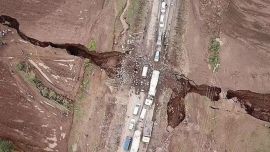I’m writing from Posadas, Misiones Province, where the Argentine media publishers association (ADEPA) has just held its annual Assembly. There seems to be an initial change in the organisation’s posture towards Javier Milei and his attacks on the press.
For the past nine months, the President and his libertarian horde on social media have singled out journalists and media outlets as some of their main enemies. It was part of a well-crafted political strategy probably orchestrated by Milei’s star advisor Santiago Caputo, taking a page from the standardised manual of rightist authoritarianism that The New York Times Company chair Arthur Gregg Sulzberger eloquently described in a recent piece titled, “How the quiet war against press freedom could come to America,” published in The Wall Street Journal.
Milei, who is a by-product of the media ecosystem (having caught his break as a late-night TV panellist who quickly went viral on social media), has taken specific actions to curb press freedom, attacking the industry’s finances while at the same time limiting journalists’ access to information. In a recent and controversial DNU emergency decree, the Milei administration indicated that “private” information related to the President and other officials was out of the scope of requests for public information, meaning that effectively such details were removed from the potential scrutiny of journalists and other members of civic society. At the same time, the president and some of his leading digital henchmen like Daniel Parisi (aka. ‘El Gordo Dan’), have engaged in systematic attacks against journalists, politicians, and any public figure who has a critical view of the Milei administration, oftentimes using aggressive and offensive language, images, videos, and memes aimed at humiliating and ultimately silencing potential dissidents.
Such practices lead to self-censorship and also the erosion of trust in the media, and democracy more generally. All of these issues are increasingly global, occurring simultaneously throughout the globe, both representing a certain decadence of the traditional socio-political model of financialised capitalism and Western liberal democracy. It is also traversed by huge technological change, where the proliferation of smartphones, the amazing reach of social media, and the power to use or influence algorithms aimed at maximising user attention, has fed polarisation, along with the rise of disinformation.
While in Posadas, I had the fortune to virtually moderate a keynote address by David Agranovich, Meta’s director for global threat disruption, who previously acted as director for intelligence at the National Security Council at the White House. Agranovich’s team works on detecting, disrupting, and deterring bad actors seeking to spread disinformation. They identify coordinated inauthentic behaviour (CIB) by focusing on the digital behaviour of these actors, as opposed to looking at the content they spread.
Interestingly, digital mercenaries or “for hire operators” are taking the lead as opposed to state actors, making it more difficult to identify who is behind these operations. In Agranovich’s team’s latest “Adversarial Threat Report,” the authors indicate that Russia tops their list of CIB campaigns, with 39, followed by Iran (30), and China (11). In Russia’s case, the priority appears to be aimed at decreasing support for the government of Ukraine, to the point where the reports suggest that operators will be actively supporting Donald Trump while they strike at Kamala Harris’ campaign in the upcoming presidential election: “Between now and the US elections in November, we expect Russia-based operations to promote supportive commentary about candidates who oppose aid to Ukraine and criticise those who advocate for aiding its defences. This could take the shape of blaming economic hardships in the US on providing financial help to Ukraine, painting Ukraine’s government as unreliable, or amplifying voices expressing pro-Russia views on the war and its prospects.”
Interestingly, Agranovich’s team notes that the emergence of generative artificial intelligence (genAI) is not an absolute game-changer – yet. “Our findings so far suggest that Gen-AI powered tactics provide only incremental productivity and content-generation gains to the threat actors, and have not impeded our ability to disrupt their influence operations.” During the conversation in Posadas, Agranovich also noted that the need to be proactive in the battle against disinformation is essential, indicating that other platforms such as X (formerly Twitter), had reduced its security operations, leading to damaging effects on their business.
Ultimately, the current socio-political environment is increasingly hostile to the press. Populist leaders across the globe are using journalism as a punching bag that is part of their “always on” campaigning, as societies have lost their trust in the media. (A big portion of this loss of trust is well deserved, given the spurious actions of several major outlets over the past several decades). At the same time, the prevalence of the Internet as the global information highway created a troubling obstacle for media companies after decades of financial comfort.
The crisis facing traditional media is nearly 30 years old and it doesn’t seem anywhere near done, as the dominance of the digital world is concentrated in a few hands. Thus, the Alphabets (Google) and Metas (Facebook) of this world have upended the market given the stupendous products they created, leaving the media cash-strapped. That’s called competition, but then, they went full monopoly mode, manipulating the market to retain the great majority of potential revenue within their ecosystems. As media companies struggle or go bust, the investment in newsroom talent falls, while the risk of news organisations falling prey to interest groups rises. The ultimate consequence is that not only has journalism lost society’s trust, but it is stuck in a vicious cycle where it becomes less and less sustainable and therefore its quality is diminished.
All of this is occurring at an amazing historical moment to engage in critical journalism. The toolkit of the modern journalist is the most powerful it’s ever been, starting with a smartphone and access to the Internet, including things like big data, artificial intelligence, and global interconnectedness. A great example of this are open source intelligence (OSINT) investigations like the ones conducted by Bellingcat. Not only are the best tools available for relatively cheap, but the political ecosystem is going through a revolution where extremist populists are rising to power, questioning the very essence of liberal democracies. Investigating and exposing the contradictions of characters like Javier Milei, Jair Bolsonaro, and Donald Trump, to name some of the major players of the global “new right,” is an attractive and fascinating endeavour. Deep polarisation and a certain overshoot of “leftist” or “progressive” causes is also ripe territory for journalism at a time where it is absolutely necessary for society to have a critical view of itself.
It is the media industry that must take care of itself in the first place, identifying threats and trying to come up with positive solutions. It is absolutely necessary to make a stand against the authoritarian streak of the Milei administration, as happened during the Kirchnerite years. Both on the journalistic and the financial side, with the president actively seeking to bankrupt companies in the sector. It’s important to address the inequities of the digital ecosystem, with Big Tech actively competing unfairly with the rest of the players, including media companies, and particularly with the rise of AI. And, ultimately, journalism needs to prove itself to the public once again, regaining its trust and therefore its demand for our products.
The road ahead is clearly sinuous, but for those who make it to the other side there should be a bright future.




















Comments